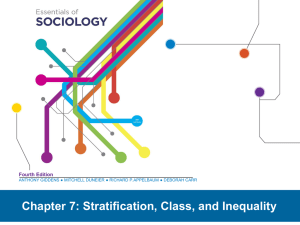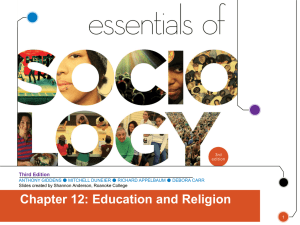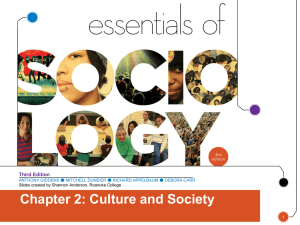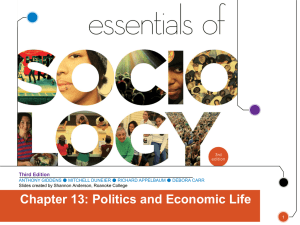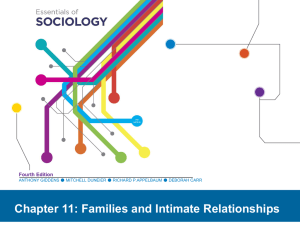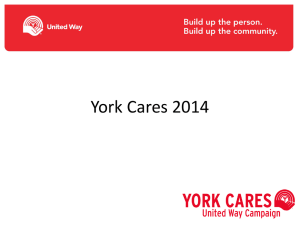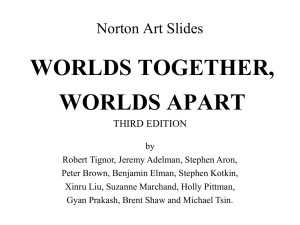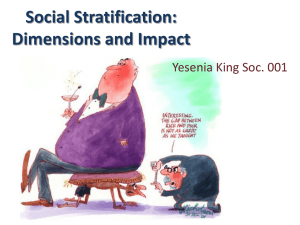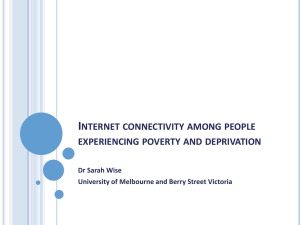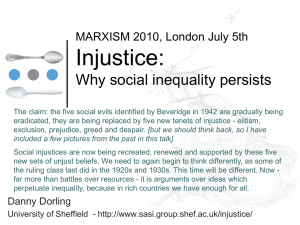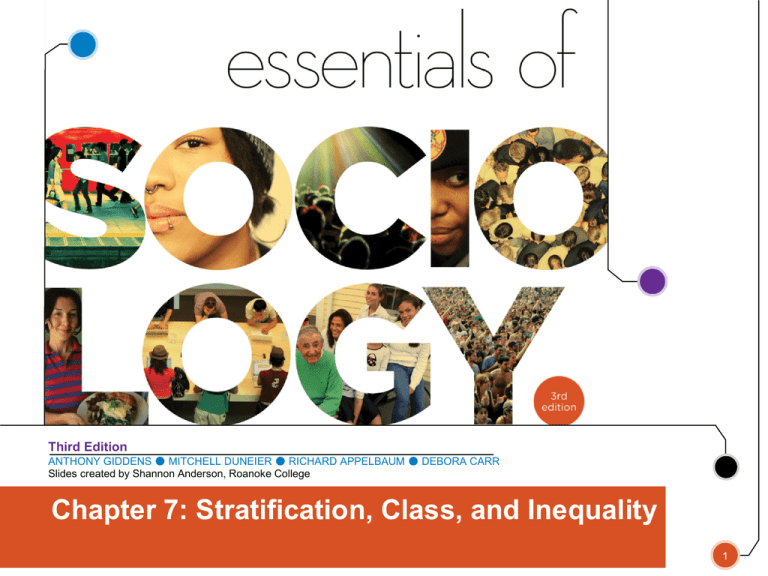
Third Edition
ANTHONY GIDDENS ● MITCHELL DUNEIER ● RICHARD APPELBAUM ● DEBORA CARR
Slides created by Shannon Anderson, Roanoke College
Chapter 7: Stratification, Class, and Inequality
1
Social stratification
• Social stratification is structured inequality
between groups.
• This inequality may be based on economics,
gender, race, religion, age, or another factor
• What is at play is power.
© 2011 W. W. Norton Co., Inc.
2
Characteristics of
stratification systems
•
•
•
Systems of inequality are organized around
groups with a shared characteristic.
The social location of a group is significant
in terms of the life chances of members.
Rankings of groups change only very slowly.
© 2011 W. W. Norton Co., Inc.
3
Three basic models
• Slavery—ownership of certain people
• Caste—status for life
• Class—positions based on economics
© 2011 W. W. Norton Co., Inc.
4
Class systems
• In modern societies, class systems dominate.
• While class systems do allow for social
mobility, opportunities are not evenly
distributed across social groups.
• Class has a significant impact on many aspects
of life, including education, occupation, place
of residence, marriage partner, and more.
© 2011 W. W. Norton Co., Inc.
5
Figure 7.1 The Kuznets Curve
Essentials Of Sociology, 3rd Edition
Copyright © 2011 W.W. Norton & Company
How do stratification systems
look today?
• In modern, industrialized societies, there is little
overt support for rigid systems of inequality.
• Remaining caste systems appear to be
transitioning into class systems.
• From the time of World War II to the 1970s, class
boundaries appeared to soften, but they have been
hardening since the 1970s.
© 2011 W. W. Norton Co., Inc.
7
Marx and class conflict
• Karl Marx was very interested in class relations in
capitalist societies.
• Class was determined solely by one’s relation to
the means of production.
– Proletariat and bourgeoisie
– Group membership utterly determined life
chances.
• Ultimately the proletariat would overthrow the
bourgeoisie, ending the reign of capitalism.
© 2011 W. W. Norton Co., Inc.
8
Weber: Class and status
• For Max Weber, position in a stratification
system was not based on economics alone:
social status was also significant.
• Weber’s multidimensional approach is
attractive to those who believe that social
prestige and power can be independent of
economics.
© 2011 W. W. Norton Co., Inc.
9
Functionalist approaches
• Functionalist theorists attempt to understand
what role inequality plays in keeping society at
equilibrium.
• Davis and Moore (1945) argued that
stratification benefited society by ensuring that
the most important roles would be filled by the
most talented and worthy people.
© 2011 W. W. Norton Co., Inc.
10
What is social class?
• Social class is some mixture of:
– Wealth
– Income
– Education
– Occupation
© 2011 W. W. Norton Co., Inc.
11
Race and wealth
• Though race is not an actual component of
class, there is a clear intersection.
• Research shows that non-whites generally
have less wealth and education than other
social groups.
• Non-whites are also much more likely to
experience discrimination when buying homes.
© 2011 W. W. Norton Co., Inc.
12
Social Inequality in the U.S.
Median net worth of American families based on various social factors
$300,000
EDUCATION
No high school
High school
$225,000
Some college
College degree
AGE
0
55
35
65
45
75
$150,000
RACE OR
ETHNICITY
$75,000
Nonwhite or Hispanic
White, non-Hispanic
HOME
OWNERSHIP
$0
Renter
Owner
Essentials Of Sociology, 3rd Edition
Copyright © 2011 W.W. Norton & Company
© 2011 W. W. Norton Co., Inc.
SOURCE: U.S. Federal Reserve Board 2009.
13
Social Inequality in the U.S.
Median net worth by percentile
$2m
$1m
$0
0%
25%
50%
75%
90%
100%
PERCENTILE OF NET WORTH
Essentials Of Sociology, 3rd Edition
Copyright © 2011 W.W. Norton & Company
© 2011 W. W. Norton Co., Inc.
SOURCE: U.S. Federal Reserve Board 2009.
14
Occupational prestige
Occupation
Accountant
Cab driver
Carpenter
Classical musician
Electrical engineer
Garbage collector
Journalist
Physician
Police officer
Real estate agent
Registered nurse
Secretary
Shoe shiner
Social worker
Sociologist
Waiter or waitress
© 2011 W. W. Norton Co., Inc.
Rank (1 = most prestigious; 16 = least
prestigious)
_________________________________
_________________________________
_________________________________
_________________________________
_________________________________
_________________________________
_________________________________
_________________________________
_________________________________
_________________________________
_________________________________
_________________________________
_________________________________
_________________________________
_________________________________
_________________________________
15
The rankings
1.
2.
3.
4.
5.
6.
7.
8.
9.
10.
11.
12.
13.
14.
15.
16.
Physician
Electrical engineer
Sociologist
Accountant
Registered nurse
Classical musician
Police officer
Journalist
Social worker
Secretary
Real estate agent
Carpenter
Cab driver
Waiter or waitress
Garbage collector
Shoe shiner
© 2011 W. W. Norton Co., Inc.
16
The American middle class
• The United States understands itself as a
middle-class society.
• This fits with strongly held ideologies,
including classlessness, meritocracy, and the
work ethic.
• Middle-class ideologies tend to promote the
reproduction of inequality.
© 2011 W. W. Norton Co., Inc.
17
Social mobility
• Social mobility is the movement of people up
or down the stratification system.
• Class systems allow for more movement than
slave or caste systems.
• Even so, it remains quite difficult to achieve
upward, intergenerational social mobility.
© 2011 W. W. Norton Co., Inc.
18
Poverty
• Despite the wealth of resources and
opportunities in the United States, poverty
remains a significant social problem.
• Sociologists discuss two general types of
poverty: absolute poverty and relative
poverty.
© 2011 W. W. Norton Co., Inc.
19
Poverty in the United States
• A full 12.5 percent of the population in 2007 was in
poverty (more than 37 million people); this is the
highest rate among the major industrialized nations.
• One-third of these people is working.
• Poverty is calculated using a formula from the
1960s, whereby the poverty line is based on an
income three times the cost of monthly groceries.
© 2011 W. W. Norton Co., Inc.
20
Why are the poor poor?
• Poverty is not simply the result of not working hard.
• Explanations for poverty are diverse.
• What we know is that low earnings (often based on a
low minimum wage) make it very hard to “get
ahead.”
• Also, the poor have less educational attainment, less
health insurance, and more broadly, diminished life
chances.
© 2011 W. W. Norton Co., Inc.
21
Gender and poverty
• Sociologists often discuss what is called the
feminization of poverty.
• Because of social changes, including divorce and the
increasing normalization of single-parenting, there
are more female-headed households today than
throughout modern U.S. history.
• Of these families, 28 percent were poor in 2007.
© 2011 W. W. Norton Co., Inc.
22
Explanations for poverty
• Sociologists have many empirical explanations
for poverty, but by and large they all fall under
one of two themes:
– Blaming the victim (culture of poverty arguments)
– Blaming the system (social exclusion, structural
arguments)
© 2011 W. W. Norton Co., Inc.
23
Poverty and social problems
• Social welfare systems
• Homelessness
• Lack of basic medical care
• Educational segregation
• People turn to non-conventional means to make
money.
© 2011 W. W. Norton Co., Inc.
24
Does inequality affect you?
• The U.S. economy is changing; that means
changing jobs, changing wages, and new
competition.
• Inequality has been on the rise for the past
three to four decades.
© 2011 W. W. Norton Co., Inc.
25
This concludes the Lecture
PowerPoint Presentation for
Chapter 7: Stratification, Class, and Inequality
For more learning resources, please visit our online StudySpace at:
http://www.wwnorton.com/college/soc/essentials-of-sociology7/
W. W. Norton & Company
Independent and Employee-Owned
© 2011 W. W. Norton Co., Inc.
26
Clicker Questions
1. What is social stratification?
a. the existence of structured inequalities between individuals and
groups in a society
b. a system in which success is based on whom you know.
c. a system based on the simple fact that some people are lucky
and others are unlucky
d. a condition that results when people’s social mobility is
hindered, such as in caste or slavery systems
© 2011 W. W. Norton Co., Inc.
27
Clicker Questions
2. If someone is poor when compared with the standard of living
for most people, he or she experiences
a. absolute poverty.
b. relative poverty.
c. downward mobility.
d. structural mobility.
© 2011 W. W. Norton Co., Inc.
28
Clicker Questions
3. What is the basis of Karl Marx’s theory of class?
a. Class is a by-product of the Industrial Revolution.
b. Modern societies are divided into those who own the means of
production and those who sell their labor.
c. People with power will always use it to project their material
interests.
d. Class is a transitory system of stratification between feudal
estates and the classlessness of communist society.
© 2011 W. W. Norton Co., Inc.
29
Clicker Questions
4. What term describes the movement of individuals or groups
between different social positions?
a. social mobility
b. social exclusion
c. social structure
d. vertical advancement
© 2011 W. W. Norton Co., Inc.
30
Clicker Questions
5. What did Max Weber add to Karl Marx’s theory of class?
a. Weber argued that income was more important than property in
determining class standing in modern society.
b. Weber argued that marketable skills were as important as
property in determining class standing and that status was as
important as class as a dimension of stratification in modern
society.
c. Weber argued that society was much too complex for anything
remotely resembling Marx’s historical materialism (his theory of
history).
d. Weber understood the enduring significance of the middle class.
© 2011 W. W. Norton Co., Inc.
31
Clicker Questions
6. Which of the following systems of stratification permit the
least amount of mobility?
a. caste
b. class
c. slavery
d. clan
© 2011 W. W. Norton Co., Inc.
32
Clicker Questions
7. Since the early 1970s, inequality in the United States has
a. increased.
b. decreased.
c. remained approximately the same
d. become more difficult to measure.
© 2011 W. W. Norton Co., Inc.
33
Art Presentation Slides
Chapter 7
Stratification, Class,
and Inequality
Anthony Giddens
Mitchell Duneier
Richard P. Appelbaum
Deborah Carr
Chapter Opener
Essentials Of Sociology, 3rd Edition
Copyright © 2011 W.W. Norton & Company
How do students derive status from the products
they buy and the clothes they wear?
Essentials Of Sociology, 3rd Edition
Copyright © 2011 W.W. Norton & Company
Women from the Dalit caste (formally known as
Untouchables) earn a living as sewage scavengers in
the slums of Ranchi, India.
Essentials Of Sociology, 3rd Edition
Copyright © 2011 W.W. Norton & Company
Figure 7.1 The Kuznets Curve
Essentials Of Sociology, 3rd Edition
Copyright © 2011 W.W. Norton & Company
Figure 7.2 Distribution of Income in the
United States, 1967– 2008
Essentials Of Sociology, 3rd Edition
Copyright © 2011 W.W. Norton & Company
Figure 7.3 Social Inequality In The U.S.
Essentials Of Sociology, 3rd Edition
Copyright © 2011 W.W. Norton & Company
Social Inequality in the U.S.
Median net worth of American families based on various social factors
$300,000
EDUCATION
No high school
High school
$225,000
Some college
College degree
AGE
0
55
35
65
45
75
$150,000
RACE OR
ETHNICITY
$75,000
Nonwhite or Hispanic
White, non-Hispanic
HOME
OWNERSHIP
$0
Renter
Owner
Essentials Of Sociology, 3rd Edition
Copyright © 2011 W.W. Norton & Company
© 2011 W. W. Norton Co., Inc.
SOURCE: U.S. Federal Reserve Board 2009.
Social Inequality in the U.S.
Median net worth by percentile
$2m
$1m
$0
0%
25%
50%
75%
90%
PERCENTILE OF NET WORTH
Essentials Of Sociology, 3rd Edition
Copyright © 2011 W.W. Norton & Company
© 2011 W. W. Norton Co., Inc.
SOURCE: U.S. Federal Reserve Board 2009.
100%
Globalization and Everyday Life
Essentials Of Sociology, 3rd Edition
Copyright © 2011 W.W. Norton & Company
Globalization and Everyday Life
Essentials Of Sociology, 3rd Edition
Copyright © 2011 W.W. Norton & Company
Table 7.1 How Has an Increase in Income
Essentials Of Sociology, 3rd Edition
Copyright © 2011 W.W. Norton & Company
Figure 7.4 Income Inequality in Selected Industrialized
Countries: Ratio of Richest 20 Percent to Poorest 20
Percent for 2008
Essentials Of Sociology, 3rd Edition
Copyright © 2011 W.W. Norton & Company
Figure 7.5 Black and Latino Household Income
Compared to Whites’
Essentials Of Sociology, 3rd Edition
Copyright © 2011 W.W. Norton & Company
Over the last two decades Tony Barbagallo has collected
around $3.6 million in stock options from companies
Essentials Of Sociology, 3rd Edition
Copyright © 2011 W.W. Norton & Company
The former governor of Florida, Jeb Bush, shares a joke with
former president George W. Bush, his brother, and his father,
former president George H. W. Bush.
Essentials Of Sociology, 3rd Edition
Copyright © 2011 W.W. Norton & Company
Figure 7.6 Percentage of Americans Living
in Poverty, 1959– 2008
Essentials Of Sociology, 3rd Edition
Copyright © 2011 W.W. Norton & Company
What does Katherine Newman’s research reveal
about the working poor?
Essentials Of Sociology, 3rd Edition
Copyright © 2011 W.W. Norton & Company
Figure 7.7 Median Income and Poverty Rates for
Households in 2008, by Race and Ethnicity
Essentials Of Sociology, 3rd Edition
Copyright © 2011 W.W. Norton & Company
Figure 7.8 Families with Children: Percentage in
Poverty, by Race and Ethnicity, Marital Status, and
Sex of Householder, 2006
Essentials Of Sociology, 3rd Edition
Copyright © 2011 W.W. Norton & Company
Figure 7.9 Percentage of the U.S. Population on Welfare
since 1960.
Essentials Of Sociology, 3rd Edition
Copyright © 2011 W.W. Norton & Company
The people who are at the greatest risk of becoming homeless are
those who work in jobs that have low wages, live in poverty,
and also struggle with personal troubles such as mental illness,
Essentials Of Sociology, 3rd Edition
alcoholism, and family problems.
Copyright © 2011 W.W. Norton & Company
W.W. Norton & Company
Independent and Employee-Owned
This concludes the Art Presentation Slides
Slide Set for Chapter 7
Essentials Of Sociology
THIRD EDITION
by
Anthony Giddens
Mitchell Duneier
Richard P. Appelbaum
Deborah Carr

